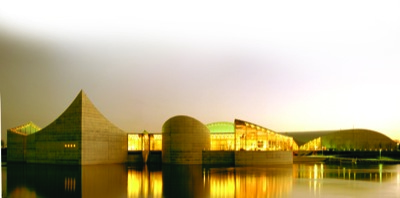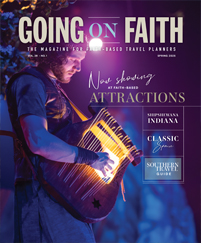 Courtesy Go Witchita
Courtesy Go Witchita
Water rolls through the city center like lifeblood, bringing an energy, vitality and beauty that sustains downtown and trickles out into the surrounding neighborhoods.
It doesn’t matter what part of the country you visit — in riverfront destinations, water is always the star of the show. Many urban centers literally grew up around rivers, and the waterways have evolved from commercial thoroughfares to recreational hotspots.
For travelers, spending time by the riverside can enhance a visit to any waterfront city. Those downtown districts often boast historic attractions, buzzing dining and entertainment complexes, and various opportunities to get out and experience the water firsthand.
There are hundreds of large and small riverfront cities all across the United States, each offering a variety of things to see and do. Here’s a look at the best ways to enjoy five great river towns.
Sacramento, Calif.
Before California became a state, the Sacramento River was an instrumental part of the 1849 gold rush that brought thousands of fortune-seekers to the West Coast, transporting travelers between inland California and the Bay Area. Today, Old Sacramento on the riverfront helps to connect visitors with the area’s history.
“Today, Old Sacramento really is our No. 1 attraction,” said Terry Selk, tourism director for the Sacramento Convention and Visitors Bureau. “Its location on the riverfront allows you to get close to the water, and take in some of the historical perspective. We retain as much of the history as possible with the architecture and the boardwalk.”
Run cooperatively by the state park service and a number of private organizations, Old Sacramento features both natural areas and a number of museums, among them a railroad museum, a history museum and a steam locomotive that runs on weekends during the summer. Those institutions are complemented by a variety of restaurants, shops and other private businesses.
One of the most interesting aspects of a visit is the underground tour.
“The city was actually built on top of an older city, because of the flooding of the river; so Old Sacramento actually has two levels to it,” Selk said. “We’re one of only three cities in the U.S. that have a formal underground walking tour. They’re being done by living-history docents.”
Pittsburgh
Situated at the confluence of the Alleghany and Monongahela rivers, Pittsburgh is the quintessential American riverside city. Visiting groups often begin their tours with a sightseeing cruise aboard one of the boats in the Gateway Clipper fleet.
“That’s a wonderful collection of five ships that do a variety of things,” said Meryl Hellring, group sales manager at the Pittsburgh Convention and Visitors Bureau. “You can do a one-hour narrated sightseeing tour that touches on all three rivers, or you can go on one of their dinner and dancing cruises.”
Adventurous groups can get an even more intimate look at the city’s river on guided kayaking tours that will take them through natural areas and underneath some of the city’s iconic bridges. Tours on amphibious “duck” vehicles allow groups to see the best sights on land and on the river.
The most popular destination on the riverfront is Station Square.
“They reclaimed the old freight house and station from the Pittsburgh and Lake Erie Railroad,” Hellring said. “They repurposed the old buildings into a multiuse shopping, dining, entertainment extravaganza. The highlight is the Grand Concourse restaurant; it was the old train station, and it has absolutely breathtaking architecture. You can eat at tables right along the windows where the river is.”
www.visitpittsburgh.com
Wichita, Kan.
Flowing through the heart of Wichita, the Arkansas River has become the cultural heart of the city. One of its chief attractions is also one of the city’s best-known images.
“The biggest attraction is called the Keeper of the Plains,” said John Rolfe, president and CEO of Go Wichita. “It’s a 44-foot statue built about 40 years ago by Black Bear Olson. It’s at the heart of the city where the Little Arkansas and the big Arkansas rivers meet.”
Recently, the statue’s surroundings were updated to create the Keeper of the Plains Plaza, which includes a pedestrian bridge and a trio of “fire pods” that light up at night.
The statue itself belongs to the Mid-American All Indian Center, one of numerous cultural institutions in the city’s Museums on the River district. Others include the Old Cowtown Museum, a living-history site that re-creates Wichita in the 1870s; Botanica, the city’s display garden; and the Wichita Art Museum.
An ongoing riverfront development is bringing more culture and commercial businesses downtown as well.
“Right on the river, we have the WaterWalk development,” Rolfe said. “It’s a business and entertainment district that has some shops, a hotel and the Kansas Sports Hall of Fame.”
Northern Kentucky
On the Kentucky bank of the Ohio River, shouting distance from Cincinnati, the riverfront areas of Covington and Newport offer groups a variety of entertainment options.
“We have Newport on the Levee, which I call our ‘eater-tainment’ center,” said Tom Caradonio, executive director of the Northern Kentucky Convention and Visitors Bureau. “There are all types of restaurants; you’ve got Johnny Rockets and fine dining at Mitchell’s. They have a bowling alley where you can do psychedelic bowling. You can go to an Irish pub or try Italian or Japanese cuisines.”
Newport on the Levee also features the Newport Aquarium, an attraction that is perennially popular with visiting groups. From there, the Purple People Bridge offers pedestrian access across the river to the Cincinnati side, where groups can enjoy a night out at the Great American Ballpark or visit the National Underground Railroad Freedom Center.
Back on the Kentucky side, a number of annual festivals keep the riverfront lively.
“There’s always a festival down at the waterfront during the spring, summer and early fall,” Caradonio said. “We have the Italian Festival and the German Festival. We have the Hofbrauhaus, which partners with the original one in Germany, and their Oktoberfest coordinates with the one in Munich.”
Detroit
In Detroit, the International Riverfront project is reclaiming more than five miles of the Detroit River waterfront, stretching from the MacArthur Bridge to the Ambassador Bridge, which leads to Canada.
The project is being headed by the Detroit Riverfront Conservancy, a nonprofit group created in 2003.
“We’re in the first phase of our project, which is what we call the East Riverfront,” said Faye Nelson, the organization’s executive director. “We’ve completed about 80 percent of that phase. It was a $300 million initiative, which includes a tremendous amount of support from the private sector.”
The project centers on the creation of the RiverWalk, with a number of interspersed parks and plazas. One featured area, Rivard Plaza, has fountains, a cafe, a bike shop, gardens and a custom-made carousel.
“It’s called the Cullen Family Carousel,” said Nelson. “The creatures were designed specifically after creatures native to our Detroit River. It also has some imaginary figures, like a river mermaid and a river monster.”
Future phases of the development call for the creation of Tri-Centennial State Park, which will be the first Michigan state park in an urban setting. The 31-acre park in the middle of downtown Detroit will include a wetlands preservation and demonstration project, as well as fishing platforms and a bike path.










